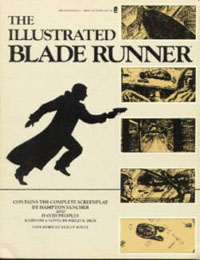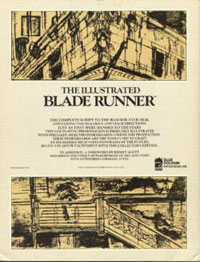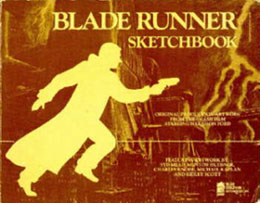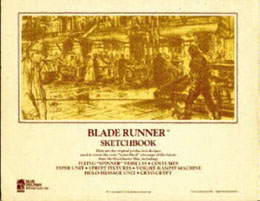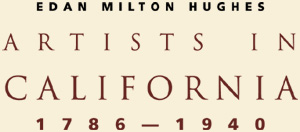FLASH
GORDON
A CANDID INTERVIEW WITH MENTOR HUEBNER
Prevue Magazine
1982
Mentor
Huebner became Flash’s permanent production illustrator
soon after shaking the South Seas sand of DeLaurentiis’
Hurricane from his hair. Traveling the globe in the course
of his profession, Huebner works wherever film producers
need him, taking advantage of the opportunity to soak up
historic atmosphere on long, weekend walks.
Spending
several months in London for Flash, Huebner was the only
English-speaking member of the Italian art department.
When
interviewed, he was working in a North Hollywood office,
planning the upcoming DeLaurentiis version of E. L. Doctorow’s
Ragtime. Personable, candid and willing to share the memories
of more than a hundred feature films since he entered the
business in 1952, Huebner was, relaxed in a room surrounded
by his charcoal and crayon drawings for Meteor, King Kong
and other big-budget blockbusters.
He
revealed he had originally visualized the staging of classic
scenes such as the chariot race from Ben-Hur and the biplane
chase through the cornfields in North by Northwest. He was
also the designer of George Pal’s memorable - Time
Machine.
“It
wasn’t one of the best of my ideas, but George was
quite taken with that whirling disk I put on the back.”
Over
the last thirty years, Huebner has served as production
designer, illustrator or art director on such movies as
The Longest Day, Fiddler on the Roof, The Amityville Horror,
10, Lord of the Rings, Forbidden Planet, Westworld, The
Great Race, Damnation Alley and the upcoming Under the Rainbow
and S.O.B.
He
has also exercised his penchant for historical settings
by designing all the necessary atmosphere for the TV productions
of The Man in the Iron Mask, The Count of Monte Cristo and
Les Miserables.
An
artist who genuinely loves to draw, Huebner creates countless
storyboards every year. He taught life-drawing classes at
a California university for 20 years, and has had numerous
gallery showings of his paintings. More than a simple draftsman,
Mentor finds that the skills required to be a first-rate
production illustrator include being a functional designer
with a thoroughly detailed knowledge of set construction,
special effects, screen composition, lighting, storytelling,
costume designing, editing, cameras, lenses, and space-time
coordination.
“The
production illustrator,” he explains, ”is the
guy who gets the script, reads, ’500 Indians sprang
out of the bushes,’ and has to solve the problems
of putting those Indians realistically on the screen. Where
do they come from? How did they get there? Are they on horses?
Where are the horses? Where have they been hiding? These
are the questions the writer didn’t resolve when he
typed the scene.
“Production
illustrators are real money-savers for producers. Some new
directors and executives don’t understand how to use
our skills effectively, and try to ramrod through situations
without storyboards. But, on a really elaborate film, with
multiple camera setups, stars and extras, 500 Indians and
their horses could cost up to $150,000 a day. Every minute
is precious. There's no time for improvising or debating
with the cameraman about the field of vision. Three bad
days on a big film could equal my income for nearly three
years. It also makes financial sense to lay everything out,
shooting as tightly and economically as possible, instead
of guessing and leaving over a half-million bucks on the
editing room floor.
“Some
directors, like Blake Edwards, use boards and collaborate
freely, usually for the chases and tricky technical problems.
Two-people-in-a-room scenes rely mostly upon the actors,
but fifty people in a room have to be choreographed for
the camera so that the audience won’t see the dolly
tracks, crane shadows, or reflector lighting panels. But
then, there are the directors who are resentful of anyone
planning their shots; it infringes on their creativity.
“Flash
Gordon was a great film experience. Working with Mike Hodges
was a real pleasure, because he’s the most sensitive
person I’ve dealt with in a long time, a marvelous
raconteur – I think he’s really a frustrated
actor at heart. He lent a sympathetic ear when I’d
say, ’ Mike, this scene just won’t play.’
We’d sit down and work out concepts together, rewriting
the script at my drawing board.
“I’ve
done about 2000 storyboards for Flash over the past two-and-a-half
years, along with a number of 20 x 40” detailed set
studies for the construction department. The script was
rewritten four or five times along the way. Much of the
drawing was very detailed because Dino wanted the technicians
to see everybody and everything in every panel.
“When
you have over $25 million invested you want to know what’s
happening to all of it. We were on six stages at Shepperton,
all the Star Wars facilities at EMI, and in a six-million-cubic-foot
complex at Brooklands. I had to do a lot of drawing to fill
all that space.”
In
addition to positioning all the people on the ground, Huebner
also had to solve a number of aerial difficulties when it
came to the scenes involving King Vultan and the Hawkmen
of Mongo. He not only designed the wing-like jet packs which
replaced the ponderous previous versions, but also had to
determine the cameraman's angles so that the Hawkmen, kept
fourteen feet apart by their wings, would appear to be only
three feet apart – conversational distance –
when delivering dialog.
In
a spectacular flying sequence, Huebner devised a way to
simulate an entire squadron of flying men with eight actors,
thirty miniatures and triple optical printing – completed
in post-production by the special effects crew under Frank
(Superman) Van der Veer’s supervision. The man who
actually constructed the Hawkmen’s wings, Glenn Robinson,
performed a similar task 40 years ago for The Wizard of
Oz’s flying monkeys.
The
essential plot for the DeLaurentiis Flash Gordon is rather
like the original comic strip – Flash, Dale and Dr.
Zarkov fly to Mongo to avert an interplanetary collision.
Princess Aura, King Barin and other familiar characters
turn up during the struggle to overcome the tyranny of Ming
the Merciless.
“The
Earth settings have been updated by screenwriter Lorenzo
Semple Jr., who reportedly received $225,000 for the finished
script. ”But,” interjects Huebner, ”even
the most talented writers forget simple time and space problems
when they are concentrating on the dramatic instead of the
visual end of the story.
“At
one point, we used a 175-foot-long set with Ming’s
throne constructed at one end: Flash was to crash his rocket
at the opposite end, go through a corridor, and up the stairs
to the throne. I got the screenplay and found the landing
scene described only as ’Flash Gordon staggers out
of his crashed rocket and says to Ming – “Oh,
yeah?”
“The
two actors ar e 175 feet apart! I had to block out a series
of shots with various angles and quick takes to signify
a short passage of time, just to bring Ming and Flash together.
It was nothing sensational, just necessary for the story
flow.”
Though
his storyboards resemble elaborate comic book panels, and
function in much the same way, Huebner’s attention
to detail and practicality goes far beyond the four-color
realm, even on such a comics-inspired project as Flash Gordon
.
“I
remember the original Alex Raymond strips quite well, and
we had the reprinted books in my office, Mike’s and
Dino’s. We used what we could, but some designs were
too impractical to build, so we adapted the material, and
retained the artistic flavor.
“I
like working with Dino, even though he can be very demanding.
He treats me with consideration. He’ll call me and
say, ’Hey, Mentor. I want you to go to England tomorrow
morning, work maybe five, six weeks.’ Then, he will
see to it I’m put up in a nice hotel and be well taken
care of. He’s not like a lot of producers who won’t
even let you go to the library for research – they
figure you have been hired to draw, so they damn near chain
you to the board, and wont spring for bus fare to Burbank.”
Few
of his drawings are ever returned to Huebner, not even those
done for films which were never made. ”They’re
stolen,” he explains. ”People take them for
souvenirs. I try to get as many as I can myself, because
they’re valuable to me as a guide to what I’ve
already done. The rest wind up on producers’ walls,
some studio files and in film archives.
“As
an artist, I appreciate audience reaction to my work, even
if nobody knows that the scenes they're watching developed
partially through my efforts. But the projects that are
most frustrating will always be the ones that never quite
got off the ground, like the handful I designed with George
Pal, including for the film, Iceberg, which he was working
on when he died.
“I
like production illustration because it presents me with
challenging situations which require my particular ability
to both draw and work out the mechanics of getting a good
shot or pacing a difficult scene. Often, just the quality
of my work is satisfying, particularly if I am able to create
a cohesive overall atmosphere for a film. Sometimes, I’ll
see the movie in a theater just to find out if it works
with the audience.
“In
an illustrative sense, I am directing movies on paper. I’ve
even toyed with the idea of becoming a Director, but I’m
not sure I could handle the actors well. I’m too used
to nailing them down on my drawing hoard – I don’t
know if I’d like to start watching them move around
all by themselves.”
The
storyboards reproduced in this special PREVUE portfolio
are from Huebner’s personal files and present prime
examples of his work on Flash. Note the skilled familiarity
with which he draws the human figure reflecting his many
years of study. Many production artists have an awkward,
architectural approach towards drawing people, as opposed
to Mentor’s easy facility, solid mastery of forms
and appealing warmth and humanity.
Note
Huebner’s skill with cinematic imagery and the sequential
staging of action, supplemented by directional arrows to
indicate camera motion and character movement. By constantly
altering sizes of elements, points of view and angles of
vision, he introduces stimulating visual variations which
engage viewer interest. By focusing on even the unimportant
details and rendering every figure in the crowd scenes,
Mentor conveys an accurate impression of exactly what figures,
textures and emotional impressions the camera should see.
*
“This
sequence * is from one of the earlier
drafts of the screenplay,” Huebner explains, “and
has been altered somewhat for the final version. The soldier
who throws himself on the sword was changed into a Lionman
and put into an arena with a monster, I believe, to tie
into the original Flash Gordon material.
“This
was the way I originally staged the initial face-off between
Flash and Ming, just after their landing on Mongo, juggling
over a half-dozen major characters, and trying to show what
types of personalities they have through the pictures alone.
As you can see, Flash doesn't fare to well in this sequence.
“But
then, this is Flash Gordon we're dealing with, and the movie
has only just begun.”
|










